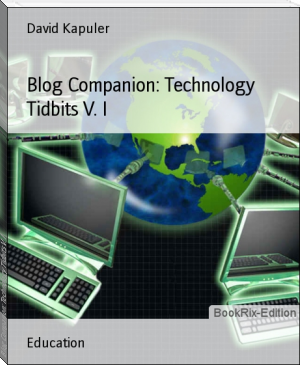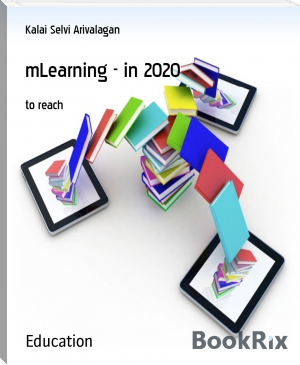INNOVATIONS IN SCIENCE, TECHNOLOGY AND MATHEMATICS EDUCATION IN NIGERIA by Ebele C. Okigbo, Nneka R. Nnorom, Ernest O. Onwukwe (the ebook reader .txt) 📖

- Author: Ebele C. Okigbo, Nneka R. Nnorom, Ernest O. Onwukwe
Book online «INNOVATIONS IN SCIENCE, TECHNOLOGY AND MATHEMATICS EDUCATION IN NIGERIA by Ebele C. Okigbo, Nneka R. Nnorom, Ernest O. Onwukwe (the ebook reader .txt) 📖». Author Ebele C. Okigbo, Nneka R. Nnorom, Ernest O. Onwukwe
This finding is in agreement with the findings of Jegede, Alaiyemola and Okebukola (1990) that student taught with concept mapping scored significantly higher that the control group. These findings agree with those of Okafor and Okeke 2006, Okafor and Okeke 2018). This was why Perry and Downs in Okafor and Okeke (2006) earlier concluded that students do not understand thoroughly concepts underlying solutions and as such try to memorize these concepts. And that such inability to transfer knowledge for the control group is as a result of superficial and rote learning. Moreover, concept mapping as an activity based-strategy/hands-on-and minds-on activities enhances meaningful understanding of scientific concepts (Okebukola, 1992, Esiobu and Soyib, 1992, Okafor and okeke 2006, Nzewi, 2011, Okafor and Okeke 2018, etc.
Consequent upon these findings, therefore, concept mapping is significantly a very useful instructional technique for reducing learning difficulties, increases meaningful understanding of difficult concepts, lead to higher retention and more recall of difficult concepts in genetics.
Recommendations
1. The Federal and State Ministries of Education should make appropriate plans to expose biology teachers to training workshops on concept mapping in order to update their techniques for improving teaching and learning of difficult concepts; there by reducing learning difficulties for students.
2. Government should make available funds and sponsor the teachers’ attendance at conferences, seminar and workshops on concept mapping
3. There should be a well- planned training programme on concept mapping in teacher preparatory levels.
4. Suitable source book on concept mapping should be made available to all secondary schools’.
5. Creative and resourceful teachers who develop and use concept maps should be rewarded and motivated adequately.
6. Teachers should attend on regular basis in-service innovation oriented training workshops to keep abreast of new techniques and skills development.
Conclusively, a truly committed teacher is expected from time to time seek for better ways of improving teaching and learning of difficult concepts through engaging students in concept mapping participatory activities, to enable students learn more meaningfully, for increased performance in their SSCE which will further enable students’ pursue science-related courses for increased scientific and technological advancement of our nation engagement of students’ in concept mapping participatory activities equally reduce students’ learning difficulties and further enable them to develop proper scientific skills, knowledge, attitude and values, which that can apply presently and in future for wealth creation and sustainable living.
References
Ausubel, D.P, (1968). The psychology of meaningful verbal learning. New York: Grune and stratten Inc. Ausubel,
D.P. Novak, J.D. & Hanasain H.(1978). Educational psychology. New York: Holt Rinchart, Winston.
Bery, C.A, & Philips D.G.(1994). An investigation of relationship between logical thinking structures and The ability to construct and interpret line graphs. Journal of Research in Science teaching, 31.
Nwagbo, C & Chukelu, U. C. (2011). Effects of Biology Practical Activities on students’ process skill Acquisition,
Esiobu, G.O. & Soyibo, k (1995). Effects of concept and Vee mapping fewer than three learning modes on students “cognitive achievement in Ecology and genetics. Journal of Research in science Teaching, 32, 971-1995.
Flick, L . (1993). The meaning of Hands -on -science. Journal of Teacher Education, 4, (1) 5.
Jegede, O.J., Alaiyemola, F.T. & Okebukola, P.A (1990). The effects of concept mapping on students anxiety and achievement In biology. Journal of Research in science Teaching 27 (10), 951-96
Nwagbo, C.R (2008), Practical approach to effective teaching of local and major biotic communities (Biomes) to secondary school students’ for sustainable development. Science Teachers Association of Nigeria (STAN) Biology panel series. 41.55
Nwagbo C & Chikelu, U.C. (2011) . Effects of Biology practical activites on students’ process skill acquisition. Journal of the science Teachers’ Association of Nigeria, 46 (1), 58-69
Nzewi, U.M (2008). Practical Approach to the effective Teaching of Ecological concepts for sustainable Development. Science Teachers Association of Nigeria (STAN) Biology panel series. 1-6.
Okafor, I . & Okeke, C (2006). Concept mapping as an Effective technique for teaching difficult concepts in Biology. STAN proceeding.
Okafor, I. & Okeke, C (2018). Effect of concept mapping on secondary school students’ achievement in genetics. A paper presentation, STAN Anambra State Conference 2018.
THE INFLUENCE OF GENDER ON STUDENTS’ ACADEMIC ACHIEVEMENT IN PHYSICS USING COMPUTER ASSISTED INSTRUCTION WITH ANIMATION
Amarachukwu N. Nwoye
&
Samuel O. C. Okeke
Abstract
Gender stereotype and academic achievement of students necessitated the study to find out whether students’ gender influence their academic achievement in physics using Computer Assisted Instruction (CAI) with animation in Awka Education Zone. Two research questions guided the study and two null hypotheses were tested at 0.05 level of significance. Quasi-experimental specifically non-equivalent control group design was adopted for the study. Population was 3,438 senior secondary one (SSI) students from government owned co-educational secondary schools in the area. A sample of 167 SS I form Awka south and Dunukofia Local Government Area (LGA) was selected through multistage sampling to compose the experimental and control groups. Experimental groups were exposed to CAI with animation package produced by the researchers which is based on the content of the SS I physics scheme of work. The control groups were taught using conventional method. Instrument for data collection was Electric Charge Electric Field Achievement Test (ECEFAT) validated by three experts with a reliability index of 0.89 using KR-20 formula. Mean was used to analyze data relating to research questions while Analysis of Covariance (ANCOVA) was used to test the null hypotheses. Findings revealed that; gender (male/female) had no significant effect on students’ achievement in physics; there was significant interaction effect of treatment and gender on students’ academic achievement in physics. Based on the findings, conclusions were reached and recommendations were also made.
Keywords: Gender, academic achievement, computer assisted instruction, animation
Introduction
Gender stereotyping can limit the development of the natural talents and abilities of girls and boys, women and men, as well as their educational and professional experiences and life opportunities in general. Stereotypes about women according to European Equality Commission (2015) both result from, and are the cause of, deeply engrained attitudes, values, norms and prejudices against women. They are used to justify and maintain the historical relations of power of men over women as well as sexist attitudes that hold back the advancement of women.
Gender, defined as a distinguishing element of organisms based on the reproductive roles has been considered in various dimensions as imparting on academic achievement (Abubakar and Uboh, 2010). A major dimension of the gender- based discrepancy in achievement relates to the access to educational facilities. Ajayi and Muraina (2011) observed that in some parts of the world (sub Saharan Africa and Asia), the perception that females should be passive members of the society remain deeply entrenched. One of the more consequential arenas in which these perceptions manifest is in the field of education. In some cases, the view that gender is a significant determinant of academic achievement, especially in science is more prevalent because of the socialization patterns in the society which tend to favour the male child over the female one (Abdullahi 2007; Ayodele & Adebiyi, 2013). Okafor, (2004) expressed that differences in expectations from male and female students derive from the socialization patterns in Nigeria which tend to place enormous restrictions on the female gender and demand from her a higher input of daily domestic labour than from the male. Another dimension of the gender- based discrepancies in performance has being traced to gender- based differences in attitude. Some subjects like; chemistry, computer studies mathematics, physics, and so on are regarded as men’s while others (biology, home economics, health and physical education and so on) as women’s.
In fact, as pointed out by Adigun, Onihinwa, Irunokhai, Sada, & Adesina, (2015) parents assign task like car washing, grass cutting, bulbs fixing, climbing ladders to fix or remove things among others to the boys. On the other hand, chores like dish washing, cooking, cleaning and soon are assigned to girls. That is to say that more complex and difficult tasks are allocated to boys whereas girls are expected to handle the relatively easy and less demanding tasks. As a result of this way of thinking the larger society has tended to see girls as “weaker sex”. Consequently an average Nigerian girl goes to school with these fixed stereotypes. This also is seen in the field of science education, physics in particular. Students mainly girls sees physics as men’s subject. This brings about negative perception over physics, that it is complex to learn, difficult to assimilate and abstract in nature.
Physics is the study of matter and energy and their interaction with each other. Atadoga, Zara, Mari, and Danjuma (2016) observed that physics is an aspect of science that helps to explain the cause-effect relationships of matter and energy, and their application to natural phenomena. Its place in the scheme of things as far as science education is concerned makes it imperative for students to take the subject seriously. In spite of the importance of physics as a unifying factor for medicine, engineering and other seemingly prestigious and lucrative fields of study in life, the performances of students in physics is not commensurate with its relevance in providing human basic needs and improving the quality of life.
Academic achievement is the quality and quantity of knowledge, skills, techniques and positive attitudes, behavior and philosophy that students achieve or acquire. This achievement according to Igweh, (2012) is evaluated by mark or grade that students attain in a term or education cycle. Anene (2005) quantified academic achievement as a measure of the student’s academic standing in relation to those of other students of his/her age. This implies that academic achievement is a result oriented construct that includes the extent of performance of a desired task. In the context of this work which was done using secondary school students, academic achievement is taken as the student’s overall performance in Electric Charge Electric Field Achievement Test (ECEFAT). The purpose of testing achievement as stressed by Okoyefi and Nzewi (2015) is to help the teacher and student evaluate and estimate the degree of success attained in learning a given concept.
In view of the belief that students’ gender may have impact on the students’ academic achievement, this study studied its influence using an innovative teaching strategy. The teaching strategy used was Computer Assisted Instruction (CAI) with animation. CAI is simply the use of computer as a tool in teaching and learning while animation is processed as a part of visual information. Nwoye and Okeke (2019) opined that computer animation seems to attract learners’ attention and increase their motivation to learn. In this study, the animations are used to deliver lesson contents with planned instructions. This involves the teacher projecting and explaining the planned instructions in form of graphics, text, audio and visual files. At the end of each topic of instruction, the animation related to the concept(s) taught will be played to enhance internalization and meaningful learning. Students are meant to attempt the evaluation questions that follow before moving to the next topic. On the other hand, CAI with animation was readily available for the learner’s use during the lessons for this study and after the study the package was made available to students to learn at their own convenient and pace.
The conventional method refers to other methods used by the teacher in lesson delivery which are teacher centred. Typical examples are chalk-talk method and lecture techniques. Needless to say, that teacher-centred teaching and lecture is the most common and conventional teaching behaviour found in schools everywhere. It is really effective where sharing information need to be done in quick manner. Moreover, it is effective to teach learners who learn best by listening. Science teachers embrace conventional method in teaching the sciences because it presumably leads to easy coverage of science syllabus. Although convectional method could be effective it also presents several challenges. Ezeani (2004) pointed out that conventional method does not promote much
 The desire to acquire knowledge about the surrounding world and human society is quite natural and understandable for a person. Life is so developed that an uneducated person will never occupy a high position in any field. Humanity in its mass, and each person individually, develops objectively, regardless of certain life circumstances and obstacles, but with different intensity. The speed of development depends on the quality of training.
The desire to acquire knowledge about the surrounding world and human society is quite natural and understandable for a person. Life is so developed that an uneducated person will never occupy a high position in any field. Humanity in its mass, and each person individually, develops objectively, regardless of certain life circumstances and obstacles, but with different intensity. The speed of development depends on the quality of training.




Comments (0)